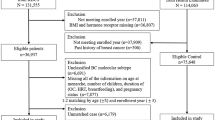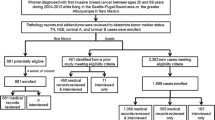Abstract
Purpose
Although controversial, obesity and underweight may have a negative impact on breast cancer outcome. However, the relationship between body mass index (BMI) and breast cancer outcomes according to tumor subtype and menopausal status remains unclear.
Methods
This study investigated the association between BMI and breast cancer outcome in stage I–III breast cancer patients. The relationships were further evaluated according to tumor subtype and menopausal status.
Results
A total of 5919 patients, 3475 (58.7%) hormone receptor (HR)(+) human epidermal growth factor receptor 2 (HER2)(–), 608 (10.3%) HR(+)HER2(+), 621 (10.5%) HR(–)HER2(+), and 1079 (18.2%) HR(–)HER2(–) were included. Underweight and obesity had a negative impact on relapse-free survival but did not affect overall survival. Importantly, the prognostic role of BMI was different according to tumor subtype and menopausal status. In HR(+)HER2(–) patients, underweight was associated with poor relapse-free survival and overall survival in pre-menopausal women. In contrast, obesity had negative impact on relapse-free survival and overall survival in HR(+)HER2(–) post-menopausal patients. Underweight may have a negative prognostic role in HR(+)HER2(+) patients. However, BMI did not impact the outcome of HR(–)HER2(+) and HR(–)HER2(–) patients.
Conclusions
The impact of BMI on breast cancer outcome was dependent on tumor subtype and menopausal status. In HR(+)HER2(–) patients, underweight and obesity had a negative prognostic role in pre-menopausal and post-menopausal women, respectively. These findings in Asian population should be further evaluated and compared in Western population.



Similar content being viewed by others
REFERENCES
Torre LA, Bray F, Siegel RL et al (2015) Global cancer statistics, 2012. CA Cancer J Clin 65(2):87–108. https://doi.org/10.3322/caac.21262
Althuis MD, Dozier JM, Anderson WF et al (2005) Global trends in breast cancer incidence and mortality 1973-1997. Int J Epidemiol 34(2):405–412. https://doi.org/10.1093/ije/dyh414
Jung KW, Won YJ, Kong HJ et al (2018) Cancer statistics in Korea: incidence, mortality, survival, and prevalence in 2015. Cancer Res Treat 50(2):303–316. https://doi.org/10.4143/crt.2018.143
Renehan AG, Tyson M, Egger M et al (2008) Body-mass index and incidence of cancer: a systematic review and meta-analysis of prospective observational studies. Lancet 371(9612):569–578. https://doi.org/10.1016/S0140-6736(08)60269-X
Renehan AG, Roberts DL, Dive C (2008) Obesity and cancer: pathophysiological and biological mechanisms. Arch Physiol Biochem 114(1):71–83. https://doi.org/10.1080/13813450801954303
Ewertz M, Jensen MB, Gunnarsdottir KA et al (2011) Effect of obesity on prognosis after early-stage breast cancer. J Clin Oncol 29(1):25–31. https://doi.org/10.1200/JCO.2010.29.7614
Chan DS, Vieira AR, Aune D et al (2014) Body mass index and survival in women with breast cancer-systematic literature review and meta-analysis of 82 follow-up studies. Ann Oncol 25(10):1901–1914. https://doi.org/10.1093/annonc/mdu042
Moon HG, Han W, Noh DY (2009) Underweight and breast cancer recurrence and death: a report from the Korean Breast Cancer Society. J Clin Oncol 27(35):5899–5905. https://doi.org/10.1200/JCO.2009.22.4436
Kawai M, Minami Y, Nishino Y et al (2012) Body mass index and survival after breast cancer diagnosis in Japanese women. BMC Cancer 12:149. https://doi.org/10.1186/1471-2407-12-149
Jeon YW, Kang SH, Park MH et al (2015) Relationship between body mass index and the expression of hormone receptors or human epidermal growth factor receptor 2 with respect to breast cancer survival. BMC Cancer 15:865. https://doi.org/10.1186/s12885-015-1879-4
Niraula S, Ocana A, Ennis M et al (2012) Body size and breast cancer prognosis in relation to hormone receptor and menopausal status: a meta-analysis. Breast Cancer Res Treat 134(2):769–781. https://doi.org/10.1007/s10549-012-2073-x
Sparano JA, Wang M, Zhao F et al (2012) Obesity at diagnosis is associated with inferior outcomes in hormone receptor-positive operable breast cancer. Cancer 118(23):5937–5946. https://doi.org/10.1002/cncr.27527
Protani M, Coory M, Martin JH (2010) Effect of obesity on survival of women with breast cancer: systematic review and meta-analysis. Breast Cancer Res Treat 123(3):627–635. https://doi.org/10.1007/s10549-010-0990-0
WHO (2000) The Asia-Pacific perspective: redefining obesity and its treatment. Health Communications Australia, Sydney
Hammond ME, Hayes DF, Dowsett M et al (2010) American Society of Clinical Oncology/College Of American Pathologists guideline recommendations for immunohistochemical testing of estrogen and progesterone receptors in breast cancer. J Clin Oncol 28(16):2784–2795. https://doi.org/10.1200/JCO.2009.25.6529
Wolff AC, Hammond ME, Hicks DG et al (2013) Recommendations for human epidermal growth factor receptor 2 testing in breast cancer: American Society of Clinical Oncology/College of American Pathologists clinical practice guideline update. J Clin Oncol 31(31):3997–4013. https://doi.org/10.1200/JCO.2013.50.9984
Petracci E, Decarli A, Schairer C et al (2011) Risk factor modification and projections of absolute breast cancer risk. J Natl Cancer Inst 103(13):1037–1048. https://doi.org/10.1093/jnci/djr172
Nelson ER, Chang CY, McDonnell DP (2014) Cholesterol and breast cancer pathophysiology. Trends Endocrinol Metab 25(12):649–655. https://doi.org/10.1016/j.tem.2014.10.001
Rose DP, Vona-Davis L (2010) Interaction between menopausal status and obesity in affecting breast cancer risk. Maturitas 66(1):33–38. https://doi.org/10.1016/j.maturitas.2010.01.019
Cunningham-Rundles S, McNeeley DF, Moon A (2005) Mechanisms of nutrient modulation of the immune response. J Allergy Clin Immunol 115(6):1119–1128. https://doi.org/10.1016/j.jaci.2005.04.036
Min SY, Kim Z, Hur MH et al (2016) The basic facts of Korean Breast Cancer in 2013: results of a Nationwide Survey and Breast Cancer Registry Database. J Breast Cancer 19(1):1–7. https://doi.org/10.4048/jbc.2016.19.1.1
Kan Z, Ding Y, Kim J et al (2018) Multi-omics profiling of younger Asian breast cancers reveals distinctive molecular signatures. Nat Commun 9(1):1725. https://doi.org/10.1038/s41467-018-04129-4
Ramachandran A, Chamukuttan S, Shetty SA et al (2012) Obesity in Asia—is it different from rest of the world. Diabetes Metab Res Rev 28(Suppl 2):47–51. https://doi.org/10.1002/dmrr.2353
Chlebowski RT, Blackburn GL, Thomson CA et al (2006) Dietary fat reduction and breast cancer outcome: interim efficacy results from the Women’s Intervention Nutrition Study. J Natl Cancer Inst 98(24):1767–1776. https://doi.org/10.1093/jnci/djj494
Pierce JP, Natarajan L, Caan BJ et al (2007) Influence of a diet very high in vegetables, fruit, and fiber and low in fat on prognosis following treatment for breast cancer: the Women’s Healthy Eating and Living (WHEL) randomized trial. JAMA 298(3):289–298. https://doi.org/10.1001/jama.298.3.289
Funding
This research was supported by a grant of the Korea Health Technology R&D Project through the Korea Health Industry Development Institute (KHIDI), funded by the Ministry of Health & Welfare, Republic of Korea (Grant No. HC17C0043).
Author information
Authors and Affiliations
Corresponding author
Ethics declarations
Conflict of interest
The authors declare that they have no competing interests.
Ethical approval
The study protocol was reviewed and approved by the institutional review board of SNUH [H-1709-052-883]. All procedures performed in studies involving human participants were in accordance with the ethical standards of the institutional and/or national research committee and with the 1964 Helsinki Declaration and its later amendments or comparable ethical standards.
Informed consent
As this study was retrospectively designed, informed consent was waived by the IRB of Seoul National University Hospital.
Additional information
Publisher's Note
Springer Nature remains neutral with regard to jurisdictional claims in published maps and institutional affiliations.
Electronic supplementary material
Below is the link to the electronic supplementary material.
10549_2019_5249_MOESM1_ESM.tif
Supplement Figure 1. Prognostic role of BMI according to tumor subtype. (1A: HR(+)HER2(-), relapse-free survival; 1B: HR(+)HER2(-), overall survival; 1C: HR(+)HER2(+), relapse-free survival; 1D: HR(+)HER2(+), overall survival). Supplementary material 1 (TIFF 889 kb)
10549_2019_5249_MOESM2_ESM.tif
Supplement Figure 2. Prognostic role of BMI according to menopause status. (2A: pre-menopausal, relapse-free survival; 2B: pre-menopausal, overall survival; 2C: post-menopausal, relapse-free survival; 2D: post-menopausal, overall survival). Supplementary material 2 (TIFF 894 kb)
10549_2019_5249_MOESM3_ESM.tif
Supplement Figure 3. Prognostic role of BMI in HR(+)HER2(+) patients stratified by menopause status. (3A: pre-menopausal, relapse-free survival; 3B: pre-menopausal, overall survival; 3C: post-menopausal, relapse-free survival; 3D: post-menopausal, overall survival). Supplementary material 3 (TIFF 877 kb)
Rights and permissions
About this article
Cite this article
Kim, J.Y., Lee, DW., Lee, KH. et al. Prognostic role of body mass index is different according to menopausal status and tumor subtype in breast cancer patients. Breast Cancer Res Treat 176, 453–460 (2019). https://doi.org/10.1007/s10549-019-05249-1
Received:
Accepted:
Published:
Issue Date:
DOI: https://doi.org/10.1007/s10549-019-05249-1




